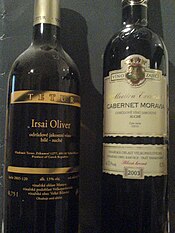Moravian Slovakia

Male and female traditional costumes worn during the Jízda Králů Festival (Ride of the Kings) held annually in the village of Vlčnov near Uherské Hradiště.

Open-air museum: vernacular architecture of Slovácko in Strážnice Skansen.

Bottles of genuine Moravian wine from the western part of Moravian Slovakia
Moravian Slovakia (Czech: Slovácko) or Slovácko is a cultural region in the southeastern part of the Czech Republic, Moravia on the border with Slovakia (Czech: Slovensko) and Austria, known for its characteristic folklore, music, wine, costumes and traditions. The area forms part of both the Zlín and South Moravian administrative regions.
Its most important center is the town of Uherské Hradiště which is located on the Morava River. Other important population centers include Uherský Brod, Břeclav, Hodonín, Strážnice and Kyjov. In the 9th century the region of Moravian Slovakia was the centre of the Great Moravian empire.
Native Moravians speak Moravian dialects of the Czech language, and the dialects native to this region are influenced by neighboring Slovak speakers, hence the name "Moravian Slovakia."[citation needed] Due to these cultural and linguistic links to Slovakia, many ethnographers until the 20th century used to consider Moravian Slovaks as a people which politically belonged to Moravia and the Bohemian Crown but ethnographically and culturally to the Slovak ethnic group. Historically, there were also significant numbers of German speakers who also influenced local speech.
Contents
1 Notable people
2 Further reading
3 Notes
4 External links
Notable people
Thomas G. Masaryk – philosopher, president of Czechoslovakia
Jan Černý – president of Moravia, PM of Czechoslovakia
John Amos Comenius – philosopher, founder of modern education, bishop of the Bohemian Brethren
František Peřina – general, RAF ace
Francis I, Prince of Liechtenstein – ruling monarch
John II, Prince of Liechtenstein – longest ruling monarch of Europe
Further reading
Johnston, Jesse A. (2010). "The Cimbál (Cimbalom) and Folk Music in Moravian Slovakia and Valachia". Journal of the American Musical Instrument Society. 36: 78–117..mw-parser-output cite.citationfont-style:inherit.mw-parser-output .citation qquotes:"""""""'""'".mw-parser-output .citation .cs1-lock-free abackground:url("//upload.wikimedia.org/wikipedia/commons/thumb/6/65/Lock-green.svg/9px-Lock-green.svg.png")no-repeat;background-position:right .1em center.mw-parser-output .citation .cs1-lock-limited a,.mw-parser-output .citation .cs1-lock-registration abackground:url("//upload.wikimedia.org/wikipedia/commons/thumb/d/d6/Lock-gray-alt-2.svg/9px-Lock-gray-alt-2.svg.png")no-repeat;background-position:right .1em center.mw-parser-output .citation .cs1-lock-subscription abackground:url("//upload.wikimedia.org/wikipedia/commons/thumb/a/aa/Lock-red-alt-2.svg/9px-Lock-red-alt-2.svg.png")no-repeat;background-position:right .1em center.mw-parser-output .cs1-subscription,.mw-parser-output .cs1-registrationcolor:#555.mw-parser-output .cs1-subscription span,.mw-parser-output .cs1-registration spanborder-bottom:1px dotted;cursor:help.mw-parser-output .cs1-ws-icon abackground:url("//upload.wikimedia.org/wikipedia/commons/thumb/4/4c/Wikisource-logo.svg/12px-Wikisource-logo.svg.png")no-repeat;background-position:right .1em center.mw-parser-output code.cs1-codecolor:inherit;background:inherit;border:inherit;padding:inherit.mw-parser-output .cs1-hidden-errordisplay:none;font-size:100%.mw-parser-output .cs1-visible-errorfont-size:100%.mw-parser-output .cs1-maintdisplay:none;color:#33aa33;margin-left:0.3em.mw-parser-output .cs1-subscription,.mw-parser-output .cs1-registration,.mw-parser-output .cs1-formatfont-size:95%.mw-parser-output .cs1-kern-left,.mw-parser-output .cs1-kern-wl-leftpadding-left:0.2em.mw-parser-output .cs1-kern-right,.mw-parser-output .cs1-kern-wl-rightpadding-right:0.2em- Bogatyrev, Petr, Richard G. Crum (1973).The functions of folk costume in Moravian Slovakia. American Anthropologist,Volume 75, Issue 6, page 1896.[1]
- Bogatyrev, Petr, (1971).The functions of folk costume in Moravian Slovakia. Mouton.
Notes
External links
![]() Media related to Moravian Slovakia at Wikimedia Commons
Media related to Moravian Slovakia at Wikimedia Commons
- The Museum of Moravian Slovakia
- Tourism website
- Information at the South Moravian Region website
Coordinates: 48°57′55.37″N 17°21′1.64″E / 48.9653806°N 17.3504556°E / 48.9653806; 17.3504556